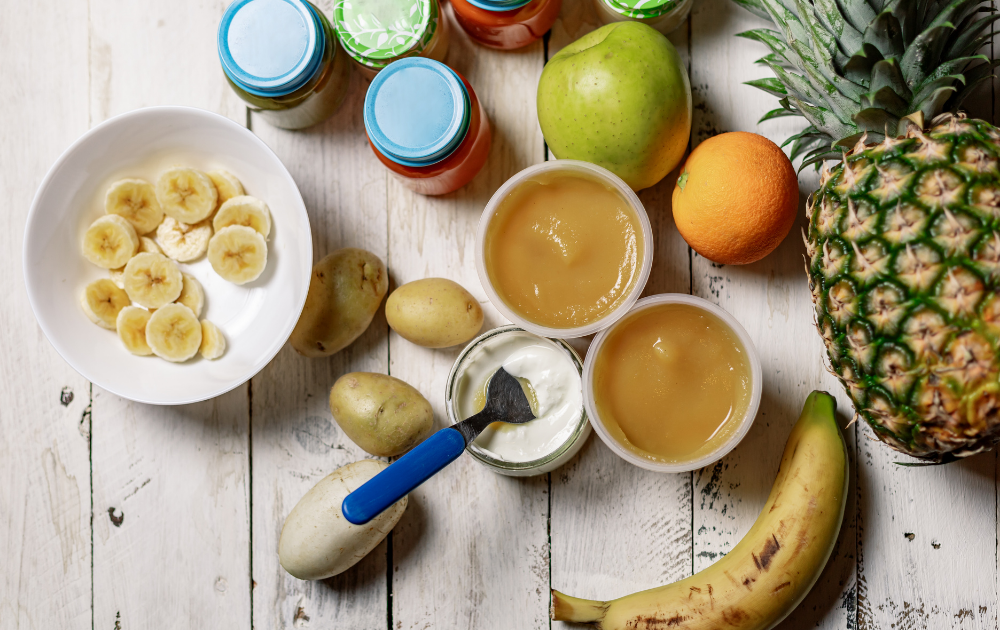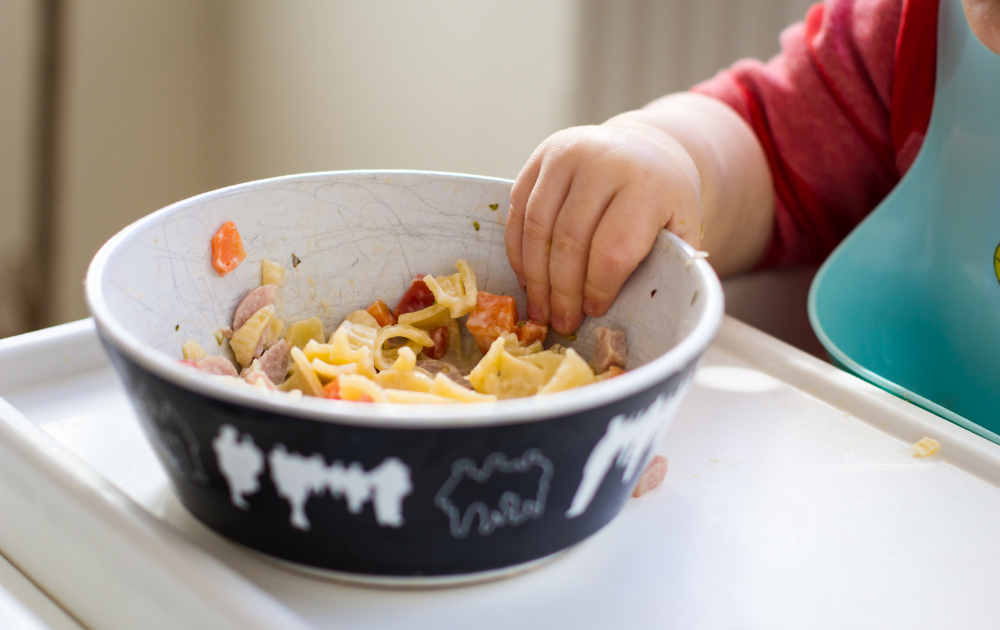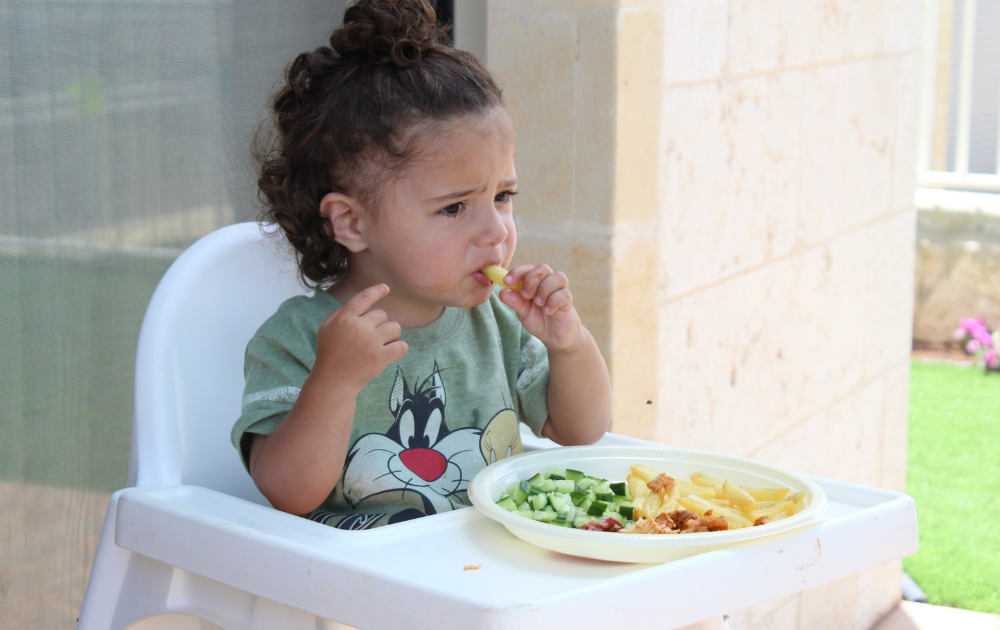
27 Apr Introduce Your Child To Solid Foods: Tips For Making The Transition Smooth
How do you know your child is ready to consume something more solid than formula or breast milk? It varies, of course, because every child develops at a unique rate, physically and emotionally. Some are ready to begin eating solid foods as early as four months, while others start signaling they want more substantial food at six months. No matter how old your baby is when they let you know they’re ready for solid food, certain tips make the transition easier for both infant and parent.
In this post, we offer ideas on how to tell your baby is ready to try solid foods, and suggest a range of foods you should introduce gradually, to ensure your baby gets all the nutrients they need.
Signals That Your Baby Is Ready:

1. They can hold up their head.
According to the American Academy of Pediatrics (AAP) this is a key sign that your baby will be able to accept solid foods. Babies reach this stage at a variety of ages, but once they independently hold their heads up, they should be able to swallow.
2. Do they still dribble food from their mouths to their chin?
If your baby can take food to the back of their tongue and swallow, you can be sure they’ll be able to handle some solid, pureed food.
3. How big are they?
The AAP suggests that babies who are double their birth weight, at least four months old, and a minimum of 14 pounds, are ready to ingest solids.
4. If the baby grasps for things, they’re ready.
Babies reaching for toys or a bottle are ready for solids. Grasping for your food is another way they signal readiness to try solids.
From Farm To Table: What To Feed Them:

The fresher the food the better it is for your baby. However, the convenience of pureed or mashed foods available at stores is invaluable, and many baby food brands are wholly organic. When time permits, cook their food yourself, then mash, puree, or slice it. As long as you offer a host of different foods, they’ll get all the daily vitamins and minerals (and calories, protein, and fat) they need to keep gaining weight.
Variety is Key
It is fair to say that, because colic has no long term effects on babies, it is parents who, in certain respects, suffer through it the most. After all, no parent wants to see their infant seemingly suffering, and not be able to calm and soothe them.
1. Start with grains

Cooked rice, barley, oats, and other grains are an ideal first solid to introduce. Rice, for example, has plenty of complex carbs and other nutrients your baby needs, and the grains are a perfect size. A small bowl of oatmeal is also perfect in texture and taste – it’s bland enough for a baby and an excellent breakfast option.
2. Introduce dairy products one at a time.
According to the Center For Disease Control in Atlanta, (CDC) parents should hold off on introducing cow’s milk or soy milk products until babies are 12 months or more. But everything else is fine – yogurt, string cheese, and eggs.
3. Introduce a new food every 3 – 5 days.

Let’s say you give your baby yogurt on Monday; wait until Friday to introduce string cheese. The CDC recommends this because it helps parents gauge whether their baby is adversely reacting to something. If they’ve had three new foods in one day, it’s harder to figure out which one may have exacerbated a skin rash, for example.
4. Don’t hold back potential allergens.

Thinking on this has changed considerably in the last decade. Once, peanuts and their products were off infants’ menus, as parents feared allergic reactions. Today, pediatricians and other experts say that there is virtually no food you shouldn’t try. Your baby will make it clear if they don’t like olives, grapes or something else, and you can always try again as they get older. Give them a tiny amount – half a teaspoon – of any food that you have concerns about. If you are truly worried about introducing nut butter, for example, talk to your doctor before giving it to your baby. They can suggest how and when to offer it, and allay any fears you may have about allergic reactions.
5. Cook meat, poultry, and fish with no skin.
This keeps the protein source from absorbing too much fat and oil when baking. Slice the meat into thin strips rather than circles – it’s easier for your baby to chew and swallow. Be sure all bones are removed – fish like sole and salmon can have tiny ones – before slicing it up and serving it to your baby. If your family is vegetarian, try tofu pureed with a vegetable.
6. Lots of fruits and vegetables.

Cook all vegetables first, then mash or puree. Some fruits, like melons, don’t need cooking, but they must be well ripened and mashed. Offer different ones as the week progresses, in different consistencies and colors. Some fruit, like apples, should be skinned first so your baby doesn’t choke on a tiny sliver or the rind or skin.
7. Don’t stop formula or breast milk right away.
These are sources of liquid your baby needs, as well as nutrients. You can offer a little water for them to sip while they are eating solids, but apart from that, babies shouldn’t need it if they’re still getting breast milk or formula. And doctors recommend holding off on fruit juice until they are older, and never letting them take a bottle to bed, in order to maintain good dental health.
Your baby is very young when you introduce solids, and how and what you feed them impacts their physical development in profound ways. For example, feeding them at the family dinner table with everyone present has, according to studies, a powerfully positive effect on babies. It helps set up healthy eating habits for life, long after you’ve stopped feeding them and they’re making food choices independently.
If you have any concerns about introducing solids to your baby, talk to your pediatrician. Otherwise, common sense, nutrition and your baby’s reaction to a variety of foods are your best guides.